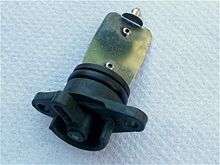Swirl flap
Swirl flaps are small butterfly valves fitted to the intake manifold just before the cylinder head intake ports of many modern automotive engines, including those from Mazda, Audi, BMW, Vauxhall and Alfa Romeo. The flaps are smaller than the intake manifold and therefore allow air to pass around them even when "closed". The photo shows a cleaned swirl flap removed from the intake manifold of a BMW M47TU 2-litre diesel engine. The flap itself is made from stainless steel and secured to a spindle by two small Torx screws. The sealing O-ring and external actuating lever can be seen below the flap itself.

Operation
Swirl flap position is adjusted by an electrical or vacuum-actuated servo mechanism which is under the control of the engine management system. In a typical implementation the flaps will be closed at idle speed, creating additional turbulence in the intake. As engine speed increases, the flaps are gradually opened until, at around 2,000 rpm, they are parallel to the airflow and present virtually no resistance. Their purpose is to ensure that the air entering the cylinder is sufficiently turbulent for good fuel-air mixing even at low engine speeds. This aids in reducing certain toxic emissions and may also improve low-end power and torque.
Disadvantages
The disadvantages of swirl flaps are mainly associated with fouling by exhaust gas recirculation, which leaves tarry deposits on the flaps and the inside of the intake manifold. Over time the flaps can begin to stick in one position and the engine management system may report an error code if the correct flap position cannot be achieved within a few percent of the design specification.
See also
- Tumble flap